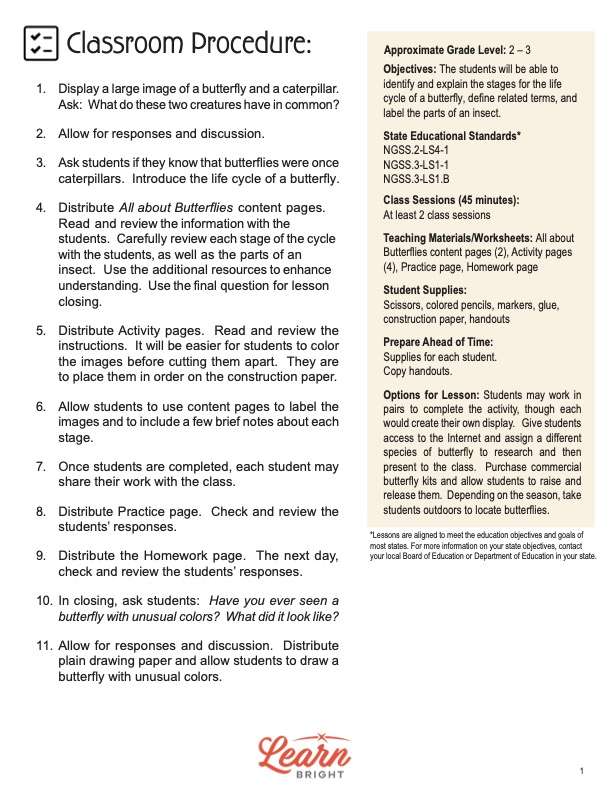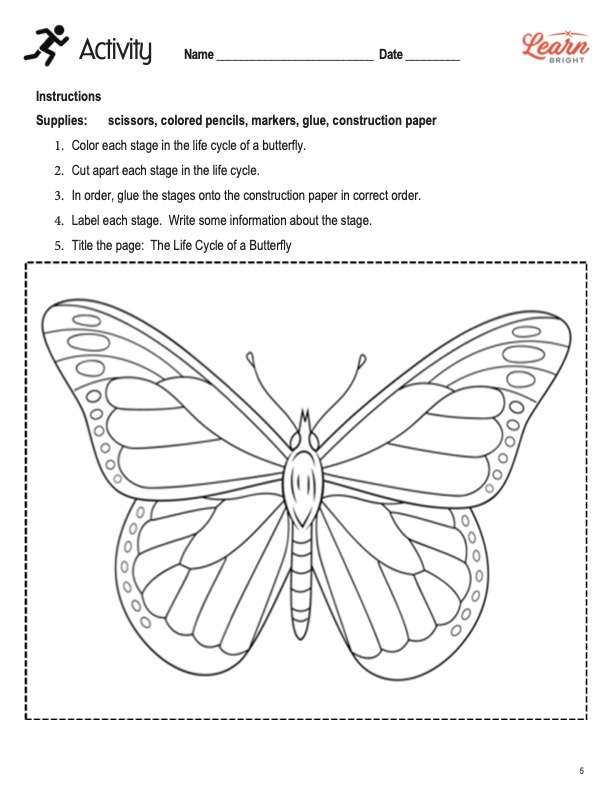Description
What our All about Butterflies lesson plan includes
Lesson Objectives and Overview: All about Butterflies teaches students all about the stages of a butterfly’s life cycle. Students will learn some vocabulary that relates to the subject matter and discover the different parts of a butterfly. This lesson is for students in 1st grade, 2nd grade, and 3rd grade.
Classroom Procedure
Every lesson plan provides you with a classroom procedure page that outlines a step-by-step guide to follow. You do not have to follow the guide exactly. The guide helps you organize the lesson and details when to hand out worksheets. It also lists information in the yellow box that you might find useful. You will find the lesson objectives, state standards, and the number of class sessions the lesson should take to complete in this area. In addition, it describes the supplies you will need as well as what and how you need to prepare beforehand. For this lesson, you will need to provide scissors, colored pencils or markers, glue, and construction paper.
Options for Lesson
You will find several suggestions in the “Options for Lesson” section of the classroom procedure page that you can consider using as well. One suggestion is to allow students to work in pairs for the activity, but still ensure each students presents their own display. Another suggestion is to assign students a specific species of butterfly to research and present to the class. You can specify the type of presentations students must prepare, or you can provide them with some freedom to choose. Another option is to purchase commercial butterfly kits and allow students to raise and release them. One other option, depending on the season, is to take the students outside and locate and observe the butterflies.
Teacher Notes
The teacher notes page provides an additional paragraph of guidance. It suggests that raising butterflies in the classroom would be an excellent activity for the students to really engage with the lesson. If you can, try to find butterfly kits as both this paragraph and the lesson options suggest. Use the blank lines to write down any other ideas or thoughts you have before presenting the lesson to your class.
ALL ABOUT BUTTERFLIES LESSON PLAN CONTENT PAGES
Introduction to Butterflies
There are two pages of content in the All about Butterflies lesson plan. The first page provides information about the butterfly and what makes it an insect. Most of these insects are beautiful, with bright and colorful wing patterns. There are nearly 20,000 different species of butterfly throughout the world. Students will discover that they can find butterflies in a wide variety of habitats. A butterfly can live in a forest, the Arctic tundra, or a backyard.
Students will learn that one thing that makes the butterfly incredible is its lifecycle. Butterflies undergo the process of metamorphosis. This is the process by which a caterpillar turns into a butterfly. The caterpillar is one of the stages of the life cycle of a butterfly. Its cells turn into the cells of a butterfly during the process, which is one of nature’s most amazing natural phenomena.
Parts of a Butterfly
Because it is an insect, the butterfly has certain parts that all other insects have. In other words, it has six legs, two antennae, a head, compound eyes, a thorax, and an abdomen. Students will discover that all insects have these traits in common. Butterflies have good eyesight and can sense the air for nectar to feed on. They can find this nectar in fruits and flowers. Adult butterflies have a long, tube-like tongue that sucks up pollen. This means that, like honey bees, they help pollinate flowers. Students might be surprised to learn that a butterfly’s taste buds are on their feet, not their tongue!
Most butterflies fly in a way that is similar to birds. Monarch butterflies actually migrate thousands of miles to lay eggs. When those eggs hatch, the new cycle of butterflies will then travel back to the original location to start a new life cycle. Some of these beautiful insects fly up to 40 miles an hour! Most, however, can only fly between five and 12 miles an hour. These creatures are delicate, so it is important to treat them carefully.
Life Cycle
The second content page provides students with a graphic that displays the life cycle of a butterfly. Stage one involves the eggs, which attach to leaves. This stage lasts for up to a couple of weeks, depending on the species. The adult female lays the eggs, which are about the size of a pinhead. Inside the eggs, caterpillars begin to grow. Once they fully develop, the caterpillars hatch from the eggs, beginning the larva stage. Their strong jaws allow them to eat leaves. They can grow up to a couple inches long. This stage only last about 5 to 10 days. Students will discover that some caterpillars shed their skin up to four times during this short period!
The pupa stage is next. In the pupa stage, the caterpillars attach themselves to a branch or underside of a leaf. One last time, they shed their skin and begin the process of metamorphosis. This stage takes up to 10 days before the butterflies are ready to emerge. Stage four, then, is when the full butterflies emerge from the pupa. A butterfly can live anywhere between just a week to a full year, depending on the species. A butterfly’s goal is to lay reproduce and lay eggs. When it does so, the life cycle begins once again.
Key Terms
Here is a list of the vocabulary words students will learn in this lesson plan:
- Metamorphosis: the process by which a caterpillar becomes a butterfly
- Larva: the second stage of the process of metamorphosis during which the insect resembles a worm or caterpillar
- Pupa: the stage at which a caterpillar or larva attaches itself to a branch or leaf to begin metamorphosis
ALL ABOUT BUTTERFLIES LESSON PLAN WORKSHEETS
The All about Butterflies lesson plan contains three worksheets: an activity worksheet, a practice worksheet, and a homework assignment. Each of these worksheets will help students solidify their understanding of the lesson content. You can refer to the guide on the classroom procedure page to know when to administer each worksheet to your students.
BUTTERFLY DISPLAY ACTIVITY WORKSHEET
For the activity, students will create a poster that displays the life cycle of a butterfly. They will color each of the four pictures that represent one of the four stages. Next, they will cut out the pictures and glue them, in order, onto a piece of construction paper. Then they will label the stages and write some information about each stage. The title for each display will be the same: The Life Cycle of a Butterfly.
MATCHING PRACTICE WORKSHEET
The practice worksheet includes two sections. The first section contains a list of 16 descriptions and a word bank that contains the four names for each of the life cycle stages. Students must match the information to the correct stage. The second part requires students to name the six parts of every insect and then define metamorphosis.
ALL ABOUT BUTTERFLIES HOMEWORK ASSIGNMENT
Students will first look at two pictures of butterflies. Using the terms in the word bank, they will draw lines and label the pictures with the correct terms. Next, they will draw lines to match the pictures to the correct life cycle stage they represent.
Worksheet Answer Keys
There are answer keys at the end of the lesson for each of the three worksheets. For the activity, answers will vary when it comes to the extra information students write on their displays. However, the key provides the correct order of the four stages and the correct labels. For the practice worksheet, the answer key provides the correct answers in red. The two short answer questions for the second section may vary from student to student, but their answer should generally match the answer key.
Likewise, there may be some variation in the first section of the homework assignment. The answer keys shows acceptable answers for the labeling of the butterfly pictures. Students’ answers for the bottom section, however, should match those of the answer key. If you choose to administer the lesson pages to your students via PDF, you will need to save a new file that omits these pages. Otherwise, you can simply print out the applicable pages and keep these as reference for yourself when grading assignments.










